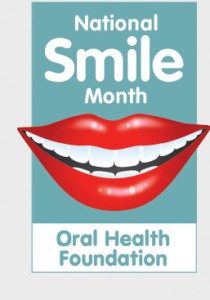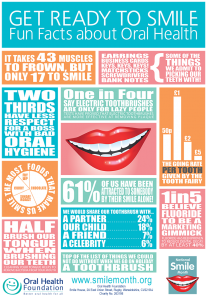National Smile Month 2017
 National Smile Month takes place between May15th to June 15th this year. This campaign was created 40 years ago and its goal is to improve people’s oral health. It focuses on raising awareness of important oral health issues and makes positive changes to millions of people. National Smile Month highlights three key messages: Brush your teeth before going to sleep and at least one other time during the day with a fluoride containing toothpaste, cut down the frequency of sugary foods and drinks and visit the dentist regularly as recommended.
National Smile Month takes place between May15th to June 15th this year. This campaign was created 40 years ago and its goal is to improve people’s oral health. It focuses on raising awareness of important oral health issues and makes positive changes to millions of people. National Smile Month highlights three key messages: Brush your teeth before going to sleep and at least one other time during the day with a fluoride containing toothpaste, cut down the frequency of sugary foods and drinks and visit the dentist regularly as recommended.
There are many ways one can get involved with the campaign. You can purchase a ‘smiley’ which has the three key messages displayed on it, take a picture with it and share it on Facebook or Twitter along with a positive message about your smile and oral health. Around half a million of people have used them over the last few years as it is fun and educational too. There are competitions you can get involved in, for example nominating somebody who has done something good or always has a smile on their face. There are many other opportunities, events that one can get involved in and make donations to provide more information and support for children, elderly and vulnerable people with special needs and those living in deprivation around England.
National Smile Months Advice For Maintaining A Health Mouth
Caring For Your Mouth
- Brush your teeth last thing at night and at least one other time during the day with a fluoride toothpaste.
- Clean in between your teeth at least once a day using interdental brushes or floss.
- To check if you have bad breath lick your wrist, let it dry and give it a sniff, if it smells your breath probably does too.
- If you use mouthwash don’t use it directly after brushing as you rinse away the fluoride from your toothpaste.
- Quit smoking to help reduce the chances of tooth staining, gum disease, tooth loss, and in more severe cases mouth cancer.
- Make sure your toothpaste contains fluoride; it helps strengthen tooth enamel making it more resistant to decay.
- Change your toothbrush every two to three months or sooner if it becomes worn as it will not clean the teeth properly.
Visiting A Dentist
- Visit your dentist regularly, as often as they recommend.
- If you are nervous about visiting the dentist, make sure they are aware of why so they can improve your treatment.
- Help to overcome dental anxiety by taking a friend with you for support or listen to music to help you relax and focus on something else.
- Your dentist will carry out a visual mouth cancer check during your regular check-up.
- Visiting a dental hygienist can help give you excellent tips and advice on preventing dental problems.
Diet And Your Oral Health
- Chew sugar-free gum after eating or drinking, especially sugary foods, to help protect your teeth and gums in between meals.
- Wait an hour after eating or drinking anything before brushing as then enamel will be softened and you could be brushing away tiny particles.
- A varied diet that is rich in vitamins, minerals, and fresh fruit and vegetables can help to prevent gum disease.
- Finishing a meal with a cube of cheese is a great, and tasty, way to reduce the effect of acids from the foods damaging your teeth.
- Avoid snacking and try to only have sugary foods and drinks at mealtimes, reducing the time your teeth come under attack.
- If you have a sweet tooth try to choose sugar free sweets and drinks which contain xylitol as it can actively contribute to your oral health.
Children’s Oral Health
- Weaning your baby off the bottle early can help them avoid developing dental problems.
- All children up to three years old, should use a smear of toothpaste with a fluoride level of no less than 1000ppm (parts per million). After three years old, they should use a toothpaste that contains 1350ppm -1500ppm.
- Parents should try and supervise your children’s tooth brushing until they are about 7 years old.
- Take your child to the dentist early, as soon as their teeth start to appear, this will help them get used to the sights, sounds and smells of a dental practice.
- Use a timer or brush a long to a song to ensure your children are brushing for the correct amount of time.
- Use a reward chart to track your children’s brushing habits and get them actively involved in brushing their teeth.
- Use disclosing tablets to show areas of your children’s mouth which may need better brushing.


